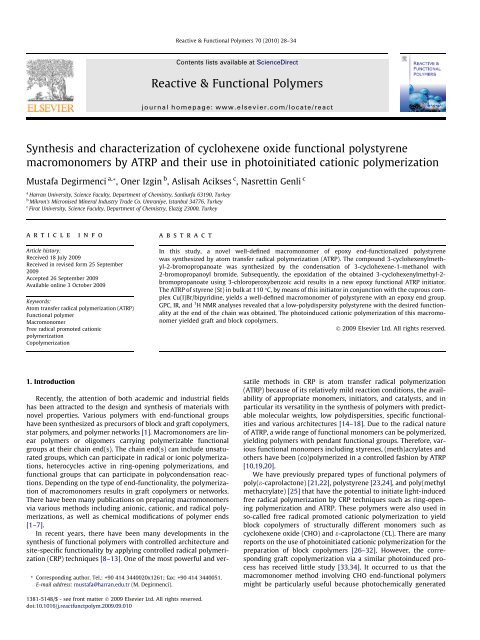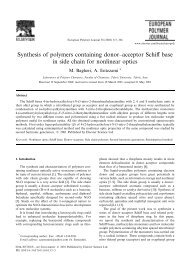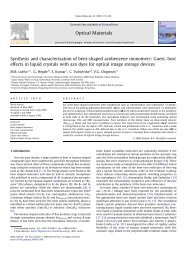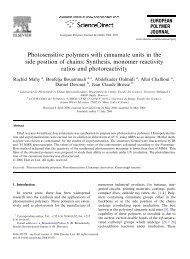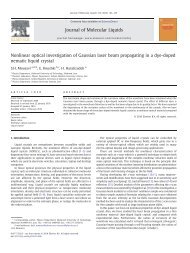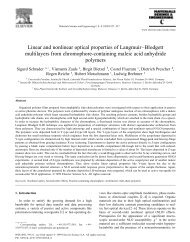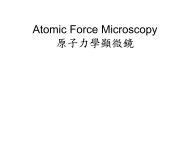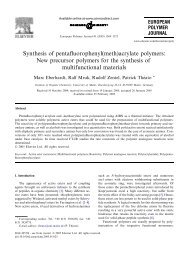Synthesis and characterization of cyclohexene oxide functional ...
Synthesis and characterization of cyclohexene oxide functional ...
Synthesis and characterization of cyclohexene oxide functional ...
Create successful ePaper yourself
Turn your PDF publications into a flip-book with our unique Google optimized e-Paper software.
<strong>Synthesis</strong> <strong>and</strong> <strong>characterization</strong> <strong>of</strong> <strong>cyclohexene</strong> <strong>oxide</strong> <strong>functional</strong> polystyrene<br />
macromonomers by ATRP <strong>and</strong> their use in photoinitiated cationic polymerization<br />
Mustafa Degirmenci a, *, Oner Izgin b , Aslisah Acikses c , Nasrettin Genli c<br />
a Harran University, Science Faculty, Department <strong>of</strong> Chemistry, Sanliurfa 63190, Turkey<br />
b Mikron’s Micronised Mineral Industry Trade Co. Umraniye, Istanbul 34776, Turkey<br />
c Firat University, Science Faculty, Department <strong>of</strong> Chemistry, Elazig 23000, Turkey<br />
article info<br />
Article history:<br />
Received 18 July 2009<br />
Received in revised form 25 September<br />
2009<br />
Accepted 26 September 2009<br />
Available online 3 October 2009<br />
Keywords:<br />
Atom transfer radical polymerization (ATRP)<br />
Functional polymer<br />
Macromonomer<br />
Free radical promoted cationic<br />
polymerization<br />
Copolymerization<br />
1. Introduction<br />
abstract<br />
Recently, the attention <strong>of</strong> both academic <strong>and</strong> industrial fields<br />
has been attracted to the design <strong>and</strong> synthesis <strong>of</strong> materials with<br />
novel properties. Various polymers with end-<strong>functional</strong> groups<br />
have been synthesized as precursors <strong>of</strong> block <strong>and</strong> graft copolymers,<br />
star polymers, <strong>and</strong> polymer networks [1]. Macromonomers are linear<br />
polymers or oligomers carrying polymerizable <strong>functional</strong><br />
groups at their chain end(s). The chain end(s) can include unsaturated<br />
groups, which can participate in radical or ionic polymerizations,<br />
heterocycles active in ring-opening polymerizations, <strong>and</strong><br />
<strong>functional</strong> groups that can participate in polycondensation reactions.<br />
Depending on the type <strong>of</strong> end-<strong>functional</strong>ity, the polymerization<br />
<strong>of</strong> macromonomers results in graft copolymers or networks.<br />
There have been many publications on preparing macromonomers<br />
via various methods including anionic, cationic, <strong>and</strong> radical polymerizations,<br />
as well as chemical modifications <strong>of</strong> polymer ends<br />
[1–7].<br />
In recent years, there have been many developments in the<br />
synthesis <strong>of</strong> <strong>functional</strong> polymers with controlled architecture <strong>and</strong><br />
site-specific <strong>functional</strong>ity by applying controlled radical polymerization<br />
(CRP) techniques [8–13]. One <strong>of</strong> the most powerful <strong>and</strong> ver-<br />
* Corresponding author. Tel.: +90 414 3440020x1261; fax: +90 414 3440051.<br />
E-mail address: mustafa@harran.edu.tr (M. Degirmenci).<br />
1381-5148/$ - see front matter Ó 2009 Elsevier Ltd. All rights reserved.<br />
doi:10.1016/j.reactfunctpolym.2009.09.010<br />
Reactive & Functional Polymers 70 (2010) 28–34<br />
Contents lists available at ScienceDirect<br />
Reactive & Functional Polymers<br />
journal homepage: www.elsevier.com/locate/react<br />
In this study, a novel well-defined macromonomer <strong>of</strong> epoxy end-<strong>functional</strong>ized polystyrene<br />
was synthesized by atom transfer radical polymerization (ATRP). The compound 3-cyclohexenylmethyl-2-bromopropanoate<br />
was synthesized by the condensation <strong>of</strong> 3-<strong>cyclohexene</strong>-1-methanol with<br />
2-bromopropanoyl bromide. Subsequently, the epoxidation <strong>of</strong> the obtained 3-cyclohexenylmethyl-2bromopropanoate<br />
using 3-chloroperoxybenzoic acid results in a new epoxy <strong>functional</strong> ATRP initiator.<br />
The ATRP <strong>of</strong> styrene (St) in bulk at 110 °C, by means <strong>of</strong> this initiator in conjunction with the cuprous complex<br />
Cu(I)Br/bipyridine, yields a well-defined macromonomer <strong>of</strong> polystyrene with an epoxy end group.<br />
GPC, IR, <strong>and</strong> 1 H NMR analyses revealed that a low-polydispersity polystyrene with the desired <strong>functional</strong>ity<br />
at the end <strong>of</strong> the chain was obtained. The photoinduced cationic polymerization <strong>of</strong> this macromonomer<br />
yielded graft <strong>and</strong> block copolymers.<br />
Ó 2009 Elsevier Ltd. All rights reserved.<br />
satile methods in CRP is atom transfer radical polymerization<br />
(ATRP) because <strong>of</strong> its relatively mild reaction conditions, the availability<br />
<strong>of</strong> appropriate monomers, initiators, <strong>and</strong> catalysts, <strong>and</strong> in<br />
particular its versatility in the synthesis <strong>of</strong> polymers with predictable<br />
molecular weights, low polydispersities, specific <strong>functional</strong>ities<br />
<strong>and</strong> various architectures [14–18]. Due to the radical nature<br />
<strong>of</strong> ATRP, a wide range <strong>of</strong> <strong>functional</strong> monomers can be polymerized,<br />
yielding polymers with pendant <strong>functional</strong> groups. Therefore, various<br />
<strong>functional</strong> monomers including styrenes, (meth)acrylates <strong>and</strong><br />
others have been (co)polymerized in a controlled fashion by ATRP<br />
[10,19,20].<br />
We have previously prepared types <strong>of</strong> <strong>functional</strong> polymers <strong>of</strong><br />
poly(e-caprolactone) [21,22], polystyrene [23,24], <strong>and</strong> poly(methyl<br />
methacrylate) [25] that have the potential to initiate light-induced<br />
free radical polymerization by CRP techniques such as ring-opening<br />
polymerization <strong>and</strong> ATRP. These polymers were also used in<br />
so-called free radical promoted cationic polymerization to yield<br />
block copolymers <strong>of</strong> structurally different monomers such as<br />
<strong>cyclohexene</strong> <strong>oxide</strong> (CHO) <strong>and</strong> e-caprolactone (CL). There are many<br />
reports on the use <strong>of</strong> photoinitiated cationic polymerization for the<br />
preparation <strong>of</strong> block copolymers [26–32]. However, the corresponding<br />
graft copolymerization via a similar photoinduced process<br />
has received little study [33,34]. It occurred to us that the<br />
macromonomer method involving CHO end-<strong>functional</strong> polymers<br />
might be particularly useful because photochemically generated
cationic species are quite reactive towards these groups. In this<br />
article, we present the results <strong>of</strong> a study <strong>of</strong> the preparation <strong>of</strong><br />
CHO end-<strong>functional</strong> macromonomers via ATRP <strong>of</strong> styrene monomer<br />
using a new CHO-<strong>functional</strong> initiator <strong>and</strong> a Cu(I)Br/bipyridine<br />
catalyst system.<br />
2. Experimental<br />
2.1. Materials<br />
Styrene (St) (Fluka) <strong>and</strong> <strong>cyclohexene</strong> <strong>oxide</strong> (CHO) (Aldrich)<br />
were distilled over calcium hydride (CaH 2) <strong>and</strong> stored in a refrigerator<br />
under nitrogen before use. The compounds 3-<strong>cyclohexene</strong>-1methanol<br />
(Aldrich), 2-bromopropanoyl bromide (Aldrich),<br />
3-chloroperoxybenzoic acid (Aldrich), <strong>and</strong> sodium bicarbonate<br />
(NaHCO 3) (Merck) were used as received. The compound 2,2-dimethoxy-2-phenyl<br />
acetophenone (DMPA) (Irgacure 651), the photoinitiator,<br />
was purchased from Ciba Specialty Chemicals <strong>and</strong> used<br />
as received without further purification. Dichloromethane (CH2Cl2)<br />
(Lab-scan) pyridine (Lab-scan), diphenyliodonium hexafluorophosphate<br />
(Ph2I + PF 6 ) (Fluka), CuBr (Aldrich), 2,2 0 -bipyridine (Merck)<br />
<strong>and</strong> all other solvents <strong>and</strong> chemicals were used as received.<br />
2.2. <strong>Synthesis</strong> <strong>of</strong> 3-cyclohexenylmethyl-2-bromopropanoate (CH–Br)<br />
For this synthesis, 3-<strong>cyclohexene</strong>-1-methanol (5.02 mL,<br />
44.6 mmol), pyridine (5.40 mL, 66.9 mmol), <strong>and</strong> 30 mL dry CH2Cl2<br />
were added to a two-necked round-bottom flask fitted with a magnetic<br />
stirrer, nitrogen inlet–outlet <strong>and</strong> an addition funnel containing<br />
2-bromopropanoyl bromide (7.07 mL, 66.90 mmol) <strong>and</strong> 5 mL<br />
dry CH2Cl2. The flask was placed in an ice-water bath. The solution<br />
<strong>of</strong> 2-bromopropanoyl bromide was added dropwise over a period<br />
<strong>of</strong> 1 h under nitrogen. The mixture was stirred at 0 °C for 30 min.<br />
The mixture was then allowed to reach room temperature <strong>and</strong> stirred<br />
at that temperature overnight. The solution was washed with<br />
0.2 N HCl <strong>and</strong> several times with water. Finally, the solution was<br />
dried with MgSO4, <strong>and</strong> the solvent was removed by vacuum distillation.<br />
A yellowish liquid product was obtained. Yield: 9.97 g, 91%.<br />
C10H15O2Br: (247,131): Calcd. C, 48.60%; H, 6.07%, Found: C,<br />
48.12%; H, 6.01%. 1 H NMR (acetone-d 6, d/ppm): 5.92–5.52 (m, 2H,<br />
HC@CH), 4.75–4.41 (q, 1H, CH–Br), 4.28–3.82 (m, 2H, OCH2),<br />
2.16–1.96 (m, 1H, OCH 2CH), 1.84–1.65 (d, 3H, CH 3CH), 1.51–1.16<br />
(m, 6H, methylene protons <strong>of</strong> <strong>cyclohexene</strong> <strong>oxide</strong> group). FT-IR<br />
Table 1<br />
<strong>Synthesis</strong> <strong>of</strong> CHO end-<strong>functional</strong> macromonomers <strong>of</strong> PSt by ATRP a using CHO–Br as initiator.<br />
(cm 1 ): 3024 (C@C–H stretch), 1739 (C@O ester b<strong>and</strong>), 1651 (C@C<br />
stretch).<br />
2.3. <strong>Synthesis</strong> <strong>of</strong> <strong>cyclohexene</strong> <strong>oxide</strong> (CHO) <strong>functional</strong> ATRP initiator<br />
(CHO–Br)<br />
Epoxidation <strong>of</strong> the 3-cyclohexenylmethyl-2-bromopropanoate<br />
was performed under inert atmosphere at 0 °C. The obtained 3cyclohexenylmethyl-2-bromopropanoate<br />
(4 g, 16.18 mmol), sodiumbicarbonate<br />
(5.437 g, 64.72 mmol), 3-chloroperoxybenzoic acid<br />
(5.58 g, 32.37 mmol) <strong>and</strong> 20 mL <strong>of</strong> dry CH 2Cl 2 were added into a<br />
100-mL three-necked round-bottom flask fitted with a condenser,<br />
a magnetic stirrer, <strong>and</strong> a nitrogen inlet–outlet. The flask was placed<br />
in an ice-water bath <strong>and</strong> stirred for 30 min. Then, the mixture was<br />
allowed to reach room temperature <strong>and</strong> stirred at that temperature<br />
for 2 h. After the reaction, the reaction mixture was added into<br />
100 mL <strong>of</strong> water, <strong>and</strong> then extracted several times with CH 2Cl 2. Finally,<br />
the solution was dried with MgSO4, <strong>and</strong> the solvent was removed<br />
by vacuum distillation. A yellowish oily product was<br />
obtained. Yield: 2.25 g, 53%.<br />
C 10H 15O 3Br: (263,130): Calcd. C, 45.64%; H, 5.70%, Found: C,<br />
45.12%; H, 5.54%. 1 H NMR (acetone-d6, d/ppm): 4.73–4.42 (q, 1H,<br />
CH–Br), 4.41–3.86 (m, 2H, OCH 2), 3.23–3.00 (m, 2H, CH–O–CH,<br />
ep<strong>oxide</strong> protons), 2.24–1.94 (m, 1H, OCH2CH), 1.82–1.62 (d, 3H,<br />
CH 3CH), 1.60–1.00 (m, 6H, methylene protons <strong>of</strong> <strong>cyclohexene</strong> <strong>oxide</strong><br />
group). FT-IR (cm 1 ): 1739 (C@O ester b<strong>and</strong>), 920 (ep<strong>oxide</strong> b<strong>and</strong>),<br />
2.4. <strong>Synthesis</strong> <strong>of</strong> <strong>cyclohexene</strong> <strong>oxide</strong> end-<strong>functional</strong> macromonomer <strong>of</strong><br />
polystyrene by atom transfer radical polymerization (CHO-PSt)<br />
A Schlenk tube equipped with a magnetic stirrer was used. The<br />
system was vacuumed <strong>and</strong> back-filled with nitrogen several times.<br />
The catalyst (CuBr), lig<strong>and</strong> bipyridine (bpy), initiator (CHO–Br), <strong>and</strong><br />
monomer (St) were introduced under inert atmosphere. The tube<br />
was placed in an oil bath warmed at 110 °C <strong>and</strong> stirred at that temperature.<br />
After a given time (see Table 1), the mixture was diluted<br />
with THF <strong>and</strong> poured into ten-fold methanol. The macromonomer<br />
(CHO-PSt) was collected after filtration <strong>and</strong> dried at 40 °C in vacuum<br />
overnight. In order to remove the complex salt from the polymer,<br />
it was redissolved in THF <strong>and</strong> passed through an alumina<br />
column, followed by precipitation in methanol.<br />
1 H NMR (acetone-d6, d/ppm): 7.52–6.39 (m, 5H, Ar–H), 4.60 (q,<br />
1H, CH–Br), 3.84–3.63 (m, 2H, OCH2), 3.23–3.00 (m, 2H, CH–O–CH,<br />
Run [I] 10 2 (mol L 1 ) Time (min) Conversion (%) Mn theo<br />
b<br />
Mn GPC Mw/Mn 1 9.7 180 45 4500 3650 1.21 4200<br />
2 28.9 90 39 1490 1590 1.27 1920<br />
3 57.9 60 59 1160 970 1.24 1025<br />
a<br />
Temperature 110 °C, [St]0 = 8.75 mol L 1 (in bulk), [I]:[CuBr]:[Bpy] = 1:1:3.<br />
b<br />
Determined by GPC according to PSt st<strong>and</strong>ards.<br />
Table 2<br />
Photoinitiated cationic polymerization <strong>of</strong> CHO-PSt macromonomer a .<br />
M n H NMR<br />
Run Photoinitiaton type Activator (mol L 1 ) Wavelength (k, nm) Mn Mw/Mn 1 Direct – 300 3940 1.60<br />
2 Promoted DMPA (5810 –3 ) 350 4110 1.44<br />
3 Sensitized Anthracene (5 10 3 ) 350 6200 1.75<br />
Conversions were calculated using the following formula: Conv.% = (W – W 0)/W 100 ; where W <strong>and</strong> W 0 are the total polymer obtained <strong>and</strong> unreacted macromonomer.<br />
a Macromonomer: 200 g L 1 with Mn = 1590; onium salt, Ph 2I + PF 6 :5 10 3 mol L 1 ; temperature: room temperature; solvent: CH 2Cl 2; irradiation time: 5 h; conversions:<br />
>99%.<br />
M. Degirmenci et al. / Reactive & Functional Polymers 70 (2010) 28–34 29
30 M. Degirmenci et al. / Reactive & Functional Polymers 70 (2010) 28–34<br />
Table 3<br />
Photoinitiated cationic polymerization CHO-PSt macromonomer with <strong>cyclohexene</strong> <strong>oxide</strong> (CHO) monomer a .<br />
Run CHO (mol L 1 ) Irradiation time (min) Yield b (%) Mn Mw/Mn Copolymer composition c (mol, %) PSt PCHO<br />
1 0.85 70 52 6800 1.75 69 31<br />
2 1.65 60 50 4700 1.89 65 35<br />
3 4.95 45 45 3200 1.90 21 79<br />
4 6.60 25 23 2500 2.14 19 81<br />
5 d<br />
9.90 20 37 4600 1.95 23 77<br />
a Macromonomer: 200 g L 1 with Mn = 1590; onium salt, Ph 2I + PF 6 : 5 10 3 mol L 1 ; temperature: room temperature; solvent: CH 2Cl 2; irradiation wavelength:<br />
k = 300 nm.<br />
b CHO conversion.<br />
c Calculated from 1 H NMR spectra <strong>of</strong> samples.<br />
d Bulk.<br />
ep<strong>oxide</strong> protons), 2.20–1.81 (m, 3H, OCH2CH, CH3CH <strong>and</strong> Ar–CH),<br />
1.80–1.21 (m, 10H, methylene protons <strong>of</strong> <strong>cyclohexene</strong> <strong>oxide</strong> group<br />
<strong>and</strong> styrene segment in polymer chain).<br />
2.5. Photopolymerization<br />
Photopolymerizations were carried out both in bulk <strong>and</strong> solution.<br />
Appropriate solutions <strong>of</strong> macromonomers containing calculated<br />
amounts <strong>of</strong> other components, shown in Tables 2 <strong>and</strong> 3,<br />
were placed in Pyrex or quartz tubes <strong>and</strong> degassed with nitrogen<br />
prior to irradiation by a merry-go-round type photoreactor<br />
equipped with 16 lamps emitting light nominally at k = 300 or<br />
k = 350 nm <strong>and</strong> a cooling system. At the end <strong>of</strong> the given time<br />
(see Tables 2 <strong>and</strong> 3 again), the polymers were poured into cold<br />
methanol, filtered, dried, <strong>and</strong> weighed. Conversions were determined<br />
gravimetrically.<br />
2.6. Characterization<br />
Fourier transform infrared (FT-IR) spectra were recorded on a<br />
Perkin–Elmer spectrum RXI FT-IR spectrophotometer. 1 H NMR<br />
spectra were measured on a Bruker 250 MHz spectrometer at<br />
ambient temperature. Gel permeation chromatography (GPC)<br />
chromatograms were obtained using a Waters instrument<br />
equipped with a R410 differential refractometer <strong>and</strong> 600E pump<br />
<strong>and</strong> with THF as the eluent, at a flow rate <strong>of</strong> 1.0 mL/min. Molecular<br />
weights were calculated using monodisperse polystyrene<br />
st<strong>and</strong>ards.<br />
3. Results <strong>and</strong> discussion<br />
OH<br />
+<br />
It has been shown that CuBr/bipyridine complex is very effective<br />
for ATRP in conjunction with alkyl halides [15]. The objective<br />
<strong>of</strong> this work was to design an initiator with <strong>cyclohexene</strong> <strong>oxide</strong><br />
(CHO) containing alkyl bromide, so as to produce CHO end-func-<br />
O<br />
O<br />
Br<br />
O<br />
Br Pyridine O<br />
Br<br />
3-chloroperoxybenzoic acid<br />
CH-Br<br />
CH-Br CHO-Br<br />
O<br />
Br<br />
O<br />
O<br />
O<br />
Br<br />
2<br />
Scheme 1. <strong>Synthesis</strong> <strong>of</strong> <strong>cyclohexene</strong> <strong>oxide</strong> (CHO) <strong>functional</strong> ATRP initiator.<br />
Fig. 1. 1 H NMR spectra <strong>of</strong> CHO–Br (a) <strong>and</strong> CHO-PSt (Table 1, run 2) (b) in acetoned<br />
6.<br />
1
Fig. 2. GPC traces <strong>of</strong> polystyrene (Table 1, run 2) (a) <strong>and</strong> poly(<strong>cyclohexene</strong> <strong>oxide</strong>)-gpolystyrene<br />
(Table 3, run 2) (b).<br />
tionalized polystyrenes <strong>and</strong> subsequently use them as a precursor<br />
for photoinitiated cationic polymerization. The ATRP initiator was<br />
prepared in two steps, as shown in Scheme 1. In the first step, 3cyclohexenylmethyl-2-bromopropanoate<br />
(CH–Br) was synthesized<br />
by the condensation <strong>of</strong> 3-<strong>cyclohexene</strong>-1-methanol with 2-bromopropanoyl<br />
bromide. In the second step, the epoxidation <strong>of</strong> obtained<br />
CH–Br using 3-chloroperoxybenzoic acid results in a new CHO<strong>functional</strong><br />
ATRP initiator (CHO–Br).<br />
The structures <strong>of</strong> initiators with <strong>cyclohexene</strong> <strong>and</strong> <strong>cyclohexene</strong><br />
<strong>oxide</strong> end groups (CH–Br <strong>and</strong> CHO–Br) were confirmed by elemental<br />
analyses <strong>and</strong> spectroscopic investigations. The 1 H NMR spectra<br />
<strong>of</strong> the CH–Br (see supporting information) <strong>and</strong> <strong>of</strong> the CHO–Br<br />
(Fig. 1a) display the signals characteristic <strong>of</strong> the corresponding segments.<br />
The characteristic peak at 5.92–5.52 ppm observed in the<br />
spectrum <strong>of</strong> CH–Br was ascribed to the protons at the double bond<br />
(–CH@CH–) <strong>of</strong> the <strong>cyclohexene</strong> ring. The other characteristic resonances<br />
originating from the CH–Br compound at 4.75–4.41 ppm,<br />
4.28–3.82 ppm, 2.16–1.96 ppm, 1.84–1.65 ppm, <strong>and</strong> 1.51–<br />
1.16 ppm, assigned to the –CH–Br, –OCH2–, –OCH2CH–, –CH3CH–,<br />
<strong>and</strong> –CH2– groups, respectively, were still present in the 1 H NMR<br />
spectrum <strong>of</strong> CHO–Br (Fig. 1a). As can be clearly seen from the 1 H<br />
O<br />
O<br />
M. Degirmenci et al. / Reactive & Functional Polymers 70 (2010) 28–34 31<br />
O<br />
O<br />
CHO-Br<br />
Br<br />
NMR spectra <strong>of</strong> related compounds, only the peak observed at<br />
5.92–5.52 ppm due to the vinyl protons completely disappeared<br />
in the spectrum <strong>of</strong> CHO–Br (Fig. 1a). Instead, new signals appeared<br />
at 3.23–3.00 ppm, which were assigned to the protons <strong>of</strong> the CHO<br />
moiety. Moreover, the FT-IR spectral analysis also supports this result<br />
(see supporting information). For example, the peak at<br />
1651 cm 1 due to the C@C stretch <strong>and</strong> the peak at 3024 cm 1<br />
due to the C@C–H stretching vibration observed in the spectrum<br />
<strong>of</strong> CH–Br spectrum completely disappeared in the spectrum <strong>of</strong><br />
CHO–Br, <strong>and</strong> a new peak at 920 cm 1 , which was assigned to the<br />
ep<strong>oxide</strong> b<strong>and</strong> was clearly observed. All these results indicated successful<br />
epoxidation <strong>and</strong> the formation <strong>of</strong> the new CHO-<strong>functional</strong><br />
ATRP initiator.<br />
The ATRP <strong>of</strong> styrene (St) was performed in bulk at 110 °C by<br />
means <strong>of</strong> an ATRP initiator (CHO–Br) in conjunction with a cuprous<br />
complex Cu(I)Br/bpy. In view <strong>of</strong> the reported role <strong>of</strong> halide groups<br />
as initiators in ATRP, this reaction was expected to produce a polymer<br />
containing a <strong>cyclohexene</strong> <strong>oxide</strong> (CHO) group on one chain end<br />
(CHO-PSt) derived from the initiator as shown in Scheme 2.<br />
As can be seen from Table 1, the measured <strong>and</strong> calculated Mn<br />
values are in good agreement, indicating that the photoinitiator<br />
added to the solution generates one growing end. By modifying<br />
the initiator concentration <strong>and</strong> the polymerization time, CHO<br />
end-<strong>functional</strong> macromonomers with various molecular weights<br />
<strong>and</strong> low polydispersities were obtained. A control experiment in<br />
the absence <strong>of</strong> styrene monomer was performed under similar<br />
ATRP conditions in order to check whether the ep<strong>oxide</strong> group<br />
(CHO) remained intact during the ATRP processes. After 2 h <strong>of</strong> reaction<br />
time, the product was isolated <strong>and</strong> characterized. The spectral<br />
<strong>characterization</strong> (FT-IR <strong>and</strong> 1 H NMR spectral measurements) <strong>of</strong> the<br />
product obtained after ATRP clearly showed the same results as<br />
CHO–Br before ATRP. This result indicated that the CHO end group<br />
was not affected under polymerization conditions.<br />
The theoretical molecular weights (Mn theo) <strong>of</strong> the CHO-PSt samples<br />
were calculated by the following equation:<br />
Mn theo ¼½MŠ 0 =½IŠ 0 Mn St Conversion þ Mn CHO—Br<br />
where [M]0 <strong>and</strong> [I]0 are the initial molar concentrations <strong>of</strong> monomer<br />
<strong>and</strong> initiator (CHO–Br), <strong>and</strong> M n St <strong>and</strong> M n CHO–Br are the molecular<br />
weights <strong>of</strong> the monomer (styrene) <strong>and</strong> initiator, respectively. The<br />
molecular weights (M n H NMR) can be calculated from the ratio <strong>of</strong><br />
aromatic protons <strong>of</strong> styrene in the CHO-PSt polymer to b protons<br />
<strong>of</strong> the <strong>cyclohexene</strong> <strong>oxide</strong> end group in the 1 H NMR spectrum. The<br />
equation is shown below:<br />
O<br />
CuBr/bpy<br />
O<br />
O<br />
Br<br />
110 o n Styrene n<br />
C, in bulk<br />
CHO-PSt<br />
Scheme 2. <strong>Synthesis</strong> <strong>of</strong> <strong>cyclohexene</strong> <strong>oxide</strong> (CHO) end-<strong>functional</strong> polystyrene macromonomer.<br />
O<br />
O<br />
CHO-PSt<br />
Br<br />
n<br />
Ph2I<br />
hν, 300 nm<br />
+ PF6 -<br />
O<br />
O<br />
PCHO-PSt comb-shaped polymer<br />
Scheme 3. Photoinitiated cationic polymerization <strong>of</strong> polystyrene macromonomer.<br />
O<br />
m<br />
Br<br />
n<br />
3<br />
4
32 M. Degirmenci et al. / Reactive & Functional Polymers 70 (2010) 28–34<br />
Mn H NMR ¼ ðI7:52 6:39=5Þ<br />
ðI3:23 3:00=2Þ Mn St þ Mn CHO—Br<br />
where I7.52 6.39 is the integral <strong>of</strong> the signals at 7.52–6.39 ppm,<br />
I 3.23 3.00 is the integral <strong>of</strong> the signals at 3.23–3.00 ppm, M n St is<br />
the molecular weight <strong>of</strong> styrene <strong>and</strong> Mn CHO–Br is the molecular<br />
weight <strong>of</strong> CHO–Br.<br />
Fig. 2a shows the GPC trace <strong>of</strong> <strong>cyclohexene</strong> <strong>oxide</strong> end-chain<br />
<strong>functional</strong> macromonomer (CHO-PSt). It is unimodal <strong>and</strong> narrow,<br />
indicating that polymerization was performed in a controlled manner<br />
<strong>and</strong> that no side reactions occurred during the ATRP process.<br />
In the 1 H NMR spectrum <strong>of</strong> the macromonomer (CHO-PSt) (Table<br />
1, run 2) can be found not only the specific signals <strong>of</strong> polystyrene<br />
(PSt) but also absorptions belonging to the rest <strong>of</strong> the<br />
initiators. As can be clearly seen from that spectrum, the epoxy<br />
end group <strong>of</strong> the polymer was conserved under the polymerization<br />
conditions (Fig. 1b).<br />
The obtained CHO end-<strong>functional</strong> macromonomers were used<br />
as precursors in the photoinitiated cationic polymerization. Table<br />
2 shows the types <strong>of</strong> photoinitiation used in our work. As can be<br />
seen from Scheme 3, homopolymerization <strong>of</strong> macromonomers provides<br />
comb-shaped polymers with a very high branch density<br />
[35,36].<br />
All the types <strong>of</strong> photoinitiation systems yielded polymers with<br />
high conversion (>99%) <strong>and</strong> basically the same structure. As expected,<br />
the molecular weight <strong>and</strong> molecular weight distribution<br />
<strong>of</strong> the obtained polymers were slightly higher than those <strong>of</strong> the<br />
macromonomer (Scheme 3). Although the conversions are so high,<br />
the molecular weights <strong>of</strong> the polymers are quite low. This is probably<br />
due to the chain entanglement <strong>and</strong> steric hindrances <strong>of</strong> high<br />
branch polymers obtained during photoinitiation. These effects<br />
prevent the initiator from reaching the macromonomer’s active<br />
site to initiate polymerization <strong>and</strong> leads to short chains even at<br />
very long reaction times. Photoinitiated cationic polymerization<br />
by direct irradiation <strong>of</strong> the iodonium salt at 300 nm presents some<br />
limitations for the potential use <strong>of</strong> PSt macromonomers because <strong>of</strong><br />
their overlapping tail absorptions. Therefore, we have also employed<br />
indirect ways, namely free radical promoted photosensitization,<br />
to provide working conditions for photoinitiated cationic<br />
polymerization at a broad wavelength range.<br />
In the radical promoted cationic polymerization, DMPA was<br />
used as the radical source, as shown in Scheme 4. The photolysis<br />
<strong>of</strong> DMPA results in a-cleavage <strong>and</strong> 2,2-dimethoxy benzyl (strong<br />
electron donor), <strong>and</strong> benzoyl (electron withdrawing) radicals are<br />
formed according to reaction 5. When irradiated in the presence<br />
<strong>of</strong> an onium salt such as diphenyl iodonium at 350 nm where<br />
O<br />
C<br />
O<br />
C<br />
O<br />
O<br />
O<br />
C<br />
O<br />
+ Ph2I +<br />
hν<br />
350 nm<br />
O<br />
O<br />
C<br />
+<br />
O<br />
C<br />
O<br />
C + + PhI + Ph<br />
C + + CHO-PSt PCHO-PSt comb-shaped polymer 7<br />
O<br />
Scheme 4. Photolysis <strong>of</strong> 2,2-dimethoxy-2-phenyl acetophenone in the presence <strong>of</strong> diphenyliodonium salt.<br />
O<br />
onium salt is transparent, the light is absorbed only by DMPA.<br />
The photochemically generated 2,2-dimethoxy benzyl radicals reduce<br />
the iodonium salt to yield corresponding carbocations [37]<br />
(reaction 6) capable <strong>of</strong> initiating cationic polymerization <strong>of</strong> the<br />
macromonomer.<br />
Fig. 3. 1 H NMR spectra <strong>of</strong> poly(<strong>cyclohexene</strong> <strong>oxide</strong>)-polystyrene graft copolymer<br />
(Table 3, run 2) (a) <strong>and</strong> poly(<strong>cyclohexene</strong> <strong>oxide</strong>)-polystyrene comb-shaped polymer<br />
(Table 2, run 2) (b) in CDCl 3.<br />
5<br />
6
Fig. 3b shows the 1 H NMR spectrum <strong>of</strong> the poly(<strong>cyclohexene</strong><br />
<strong>oxide</strong>)-polystyrene comb-shaped polymer (Table 2, run 2). Not<br />
only the specific signals <strong>of</strong> PCHO <strong>and</strong> PSt segments are visible,<br />
but also absorptions belonging to the rest <strong>of</strong> the initiator fragment.<br />
In earlier studies on photoinitiated cationic polymerization<br />
using anthracene as a sensitizer it was shown that the electron<br />
transfer, governed by energetic <strong>and</strong> thermodynamic considerations,<br />
was the dominant process. The magnitude <strong>of</strong> the free DG<br />
energy for the electron transfer should have been 10 kJ mol 1 .<br />
The DG value ( 193 kJ mol 1 ) suggests that electron transfer from<br />
singlet anthracene to iodonium ions is quite favorable [37].<br />
Anthracene radical cation or Brønsted acid formed from the hydrogen<br />
abstraction reaction may initiate the polymerization (Scheme<br />
5).<br />
Polystyrene macromonomer (CHO-PSt) was used as a comonomer<br />
in the copolymerization with CHO under similar conditions to<br />
those applied for the polymerization <strong>of</strong> the CHO-PSt macromonomer<br />
itself. Typical results concerning photochemically induced cationic<br />
copolymerization <strong>of</strong> CHO with CHO-PSt macromonomer at<br />
room temperature are shown in Table 3. As can be seen, the concentration<br />
<strong>of</strong> the CHO comonomer influences the composition <strong>of</strong><br />
the graft copolymer. The composition <strong>of</strong> the copolymers PCHO-g-<br />
PSt was determined from 1 H NMR spectra using the integrated<br />
peak ratio <strong>of</strong> the aromatic protons <strong>of</strong> styrene (6.25–7.20 ppm) in<br />
the PSt segment to the OCHCHO protons in the PCHO segment<br />
(3.36 ppm). The content <strong>of</strong> PSt units in a copolymer X (mol %)<br />
was calculated using the following formula:<br />
ðI7:20 6:25=5Þ<br />
XPSt ¼<br />
ðI7:20 6:25=5ÞþðI3:36=2Þ<br />
x<br />
O<br />
CHO<br />
100<br />
where I7.20 6.25 is the integral <strong>of</strong> the aromatic proton signals at<br />
7.20–6.25 ppm, <strong>and</strong> I 3.36 is the integral <strong>of</strong> the OCHCHO proton signals<br />
at 3.36 ppm.<br />
Using CHO-PSt macromonomer as the comonomer allowed for a<br />
rather simple incorporation <strong>of</strong> PSt side chains into poly(<strong>cyclohexene</strong><br />
<strong>oxide</strong>) (PCHO) backbone. In this way, poly(<strong>cyclohexene</strong><br />
H +<br />
hν<br />
350 nm<br />
*<br />
+ Ph2I +<br />
*<br />
<strong>oxide</strong>)-polystyrene graft copolymer with r<strong>and</strong>om sequences <strong>of</strong><br />
the following structure (PCHO-g-PSt) was formed (Scheme 6).<br />
Fig. 3b shows the GPC chromatogram <strong>of</strong> the graft copolymer<br />
(PCHO-g-PSt) that was formed. Notably, no peak pertaining to<br />
the residual homopolymer was detected. The graft copolymer<br />
structures were also assigned by means <strong>of</strong> NMR spectral measurements.<br />
As can be seen the 1 H NMR spectrum <strong>of</strong> the graft copolymer<br />
displays typical signals at 3.36 ppm <strong>of</strong> OCHCHO (PCHO) <strong>and</strong> 7.20–<br />
6.25 ppm <strong>of</strong> aromatic protons (PSt).<br />
4. Conclusions<br />
A new ATRP initiator with a CHO-<strong>functional</strong> group (CHO–Br)<br />
was synthesized by epoxidation <strong>of</strong> 3-cyclohexenylmethyl-2bromopropanoate<br />
in the presence <strong>of</strong> 3-chloroperoxybenzoic acid.<br />
The ATRP <strong>of</strong> styrene monomer using CHO–Br initiator formed a<br />
well-defined PSt macromonomer possessing CHO end groups.<br />
The obtained CHO end-<strong>functional</strong> PSt macromonomer was employed<br />
in photoinitiated cationic (co)polymerization using diphenyliodonium<br />
salt. Photoinitiation <strong>of</strong> cationic polymerizations can<br />
be efficiently achieved by using the iodonium salt at 300 nm as<br />
well as at wavelengths <strong>of</strong> about 350 nm with the aid <strong>of</strong> sensitizers<br />
<strong>and</strong> free radical sources.<br />
Acknowledgements<br />
The authors would like to thank Harran University, the Scientific<br />
Research Council (HÜBAK) <strong>and</strong> Firat University Scientific Research<br />
Projects Unit (FÜBAP) for financial support.<br />
Appendix A. Supplementary data<br />
Supplementary data associated with this article can be found, in<br />
the online version, at doi:10.1016/j.reactfunctpolym.2009.09.010.<br />
8<br />
+ PhI + Ph 9<br />
+ R-H + H + + R 10<br />
+ CHO-PSt PCHO-PSt comb-shaped polymer<br />
Scheme 5. Photolysis <strong>of</strong> anthracene in the presence <strong>of</strong> diphenyliodonium salt.<br />
+<br />
M. Degirmenci et al. / Reactive & Functional Polymers 70 (2010) 28–34 33<br />
Ph2I<br />
y CHO-PSt<br />
hν, 300 nm<br />
+ PF6 -<br />
O<br />
x<br />
O<br />
y<br />
O<br />
PCHO-g-PSt<br />
Scheme 6. <strong>Synthesis</strong> <strong>of</strong> poly(<strong>cyclohexene</strong> <strong>oxide</strong>)-g-polystyrene.<br />
O<br />
n<br />
Br<br />
11<br />
12
34 M. Degirmenci et al. / Reactive & Functional Polymers 70 (2010) 28–34<br />
References<br />
[1] Y. Yagci, O. Nuyken, V. Graubner, Telechelic polymers, in: J.I. Kroschwitz (Ed.),<br />
Encyclopedia <strong>of</strong> Polymer Science <strong>and</strong> Technology, third ed., vol. 12, John Wiley<br />
& Sons Inc., New York, 2005, pp. 57130.<br />
[2] G.F. Meijs, E.J. Rizzardo, Macromol. Sci. Chem. Phys. 30 (1990) 305.<br />
[3] T. Higashihara, R. Faust, React. Funct. Polym. 69 (2009) 429.<br />
[4] V. Percec, C. Pugh, O. Nuyken, S. Pask, Macromonomers, oligomers <strong>and</strong><br />
telechelics, in: G. Allen, J.C. Bevington (Eds.), Comprehensive Polymer Science,<br />
vol. 6, Pergamon, New York, 1989, p. 281.<br />
[5] C.L. Bao, X.M. Wang, L.S. Wang, J. Polym. Res. 16 (2009) 279.<br />
[6] T. Hagiwara, C. Shin-ichi, H. Kinoshita, Y. Masubuchi, React. Funct. Polym. 67<br />
(2007) 1225.<br />
[7] F. Ariura, M. Schappacher, R. Borsali, A. Deffieux, React. Funct. Polym. 69 (2009)<br />
402.<br />
[8] S. Yamago, E. Kayahara, H. Yamada, React. Funct. Polym. 69 (2009) 416.<br />
[9] K.A. Davis, K. Matyjaszewski, Adv. Polym. Sci. 159 (2002) 2.<br />
[10] V. Coessens, T. Pintauer, Prog. Polym. Sci. 26 (2001) 337.<br />
[11] W.A. Braunecker, K. Matyjaszewski, Prog. Polym. Sci. 32 (2007) 93.<br />
[12] H. Mori, S. Okabayashi, React. Funct. Polym. 69 (2009) 441.<br />
[13] R. Maeda, T. Hayakawa, M. Tokita, R. Kikuchi, J. Kouki, M. Kakimoto, H.<br />
Urushibata, React. Funct. Polym. 69 (2009) 519.<br />
[14] K. Matyjaszewski, J. Macromol. Sci. Pure. Appl. Chem. 34 (1997) 1785.<br />
[15] K. Matyjaszewski, J.H. Xia, Chem. Rev. 101 (2001) 2921.<br />
[16] T.E. Patten, K. Matyjaszewski, Adv. Mater. 10 (1998) 901.<br />
[17] K. Matyjaszewski, Controlled/Living Radical Polymerization: From <strong>Synthesis</strong> to<br />
Materials, American Chemical Society, Washington DC, 2006.<br />
[18] Y. Liu, M. Chen, K. Hsu, React. Funct. Polym. 69 (2009) 424.<br />
[19] V. Coessens, J. Pyun, P.J. Miller, S.G. Gaynor, K. Matyjaszewski, Macromol.<br />
Rapid. Commun. 21 (2000) 103.<br />
[20] Y. Chen, M. Sone, K. Fuchise, R. Sakai, R. Kakuchi, Q. Duan, J. Sun, A. Narumi, T.<br />
Satoh, T. Kakuchi, React. Funct. Polym. 69 (2009) 463.<br />
[21] M. Degirmenci, G. Hizal, Y. Yagci, Macromolecules 35 (2002) 8265.<br />
[22] M. Degirmenci, Polym. J. 36 (2004) 542.<br />
[23] M. Degirmenci, I. Cianga, Y. Yagci, Macromol. Chem. Phys. 203 (2002) 1279.<br />
[24] M. Degirmenci, I. Cianga, G. Hizal, Y. Yagci, Polym. Prep. 43 (2002) 22.<br />
[25] M. Degirmenci, J. Macromol. Sci. Part A: Pure Appl. Chem. 42 (2005) 21.<br />
[26] Y. Yagci, M. Degirmenci, Photoinduced free radical promoted cationic block<br />
copolymerization by using macrophotoinitiators prepared by ATRP <strong>and</strong> ROP<br />
methods, in: K. Matyjaszewski (Ed.), Advances in Controlled Radical<br />
Polymerization, ACS Symposium Series 854, American Chemical Society,<br />
Washington, DC, 2003, p. 383.<br />
[27] M. Kamachi, H.Q. Guo, A. Kajiwara, Macromol. Chem. Phys. 203 (2002) 991.<br />
[28] Y. Yagci, Macromol. Symp. 161 (2000) 19.<br />
[29] A.E. Muftuoglu, I. Cianga, S. Yurteri, Y. Yagci, J. Appl. Polym. Sci. 93 (2004) 387.<br />
[30] A.E. Muftuoglu, M.A. Tasdelen, Y. Yagci, Photoinduced synthesis <strong>of</strong> block<br />
copolymers, in: J.P. Fouassier (Ed.), Photochemistry <strong>and</strong> UV Curing: New<br />
Trends Photochemistry <strong>and</strong> Photobiology Research Signpost., Triv<strong>and</strong>rum,<br />
2006, p. 343 (Chapter 29).<br />
[31] D. Yucesan, H. Hostoygar, S. Denizligil, Y. Yagci, Die Angew. Makromol. Chem.<br />
221 (1994) 207.<br />
[32] I.E. Serhatli, G. Galli, Y. Yagci, E. Chiellini, Polym. Bull. 34 (1995) 539.<br />
[33] A. Onen, Y. Yagci, Eur. Polym. J. 28 (1992) 721.<br />
[34] M. Degirmenci, O. Izgin, Y. Yagci, J. Polym. Sci. Part A: Polym. Chem. 42 (2004)<br />
3365.<br />
[35] K. Ito, Prog. Polym. Sci. 23 (1988) 581.<br />
[36] K. Ito, S. Kawaguchi, Adv. Polym. Sci. 142 (1999) 129.<br />
[37] Y. Yagci, I. Reetz, Prog. Polym. Sci. 23 (1998) 1465.


